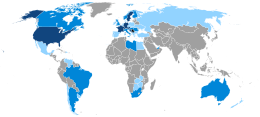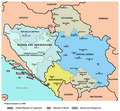จากวิกิพีเดีย สารานุกรมเสรี
ชาวเซิร์บ (อังกฤษ : Serbs , เซอร์เบีย : Срби ) เป็นกลุ่มเชื้อชาติสลาฟใต้ในบอลข่าน และตอนใต้ของยุโรปกลาง ชาวเซิร์บส่วนใหญ่มักพบอาศัยอยู่ในเซอร์เบีย มอนเตเนโกร และบอสเนียและเฮอร์เซโกวีนา และเป็นชนกลุ่มน้อยในโครเอเชีย มาซิโดเนีย และสโลวีเนีย เช่นเดียวกัน ชาวเซิร์บยังได้รับการรับรองอย่างเป็นทางการว่าเป็นชนกลุ่มน้อยในโรมาเนีย ฮังการี เช่นเดียวกับแอลเบเนีย สาธารณรัฐเช็ก และสโลวาเกีย [29] ยุโรปตะวันตก โดยเฉพาะอย่างยิ่งในเยอรมนี สวีเดน สวิตเซอร์แลนด์ และออสเตรีย เช่นเดียวกับในฝรั่งเศส และอิตาลี ชาวเซิร์บมากกว่าหนึ่งล้านคนอาศัยอยู่ในประเทศที่พูดภาษาเยอรมัน[30]
แผนที่แสดงจำนวนประชากรชาวเซิร์บที่อยู่ในเซอร์เบียและประเทศรอบๆ
แผนที่ชาวเซิร์บในยูโกสลาเวีย
ประเทศที่มีประชากรชาวเซิร์บอาศัยอยู่
แผนที่ประเทศเซอร์เบีย มอนเตเนโกร และบอสเนียและเฮอร์เซโกวีนา
↑ Popis 2013 (PDF) . Sarajevo: BHAS. June 2016. คลังข้อมูลเก่าเก็บจากแหล่งเดิม (PDF) เมื่อ 30 June 2016. สืบค้นเมื่อ 30 June 2016 .↑ "Rezultati popisa 2021. godine" . popis2021.hr . คลังข้อมูลเก่าเก็บจากแหล่งเดิม เมื่อ 9 December 2022. สืบค้นเมื่อ 2022-12-02 .↑ "Census of Population, Households and Dwellings in Montenegro 2011" (PDF) . 12 July 2011. เก็บ (PDF) จากแหล่งเดิมเมื่อ 27 July 2011. สืบค้นเมื่อ 13 July 2011 .↑ Cocozelli, Fred (2016). Ramet, Sabrina (บ.ก.). Ethnic Minorities and Politics in Post-Socialist Southeastern Europe ISBN 978-1316982778 ↑ "Slovenian census" . 2011. เก็บ จากแหล่งเดิมเมื่อ 17 November 2014.↑ Државен завод за статистика. "Попис на населението, домаќинствата и становите во Република Македонија, 2002: Дефинитивни податоци" (PDF) . เก็บ (PDF) จากแหล่งเดิมเมื่อ 22 September 2010. ↑ "Statistiche demografiche ISTAT" (PDF) . Demo.istat.it. คลังข้อมูลเก่าเก็บจากแหล่งเดิม (PDF) เมื่อ 1 April 2014. สืบค้นเมื่อ 3 October 2014 .↑ "Дијаспора може да промени Србију" .↑ "Innvandring og innvandrere 2006" (PDF) . เก็บ (PDF) จากแหล่งเดิมเมื่อ 24 September 2015.↑ "Tab11. Populaţia stabilă după etnie şi limba maternă, pe categorii de localităţi" . Rezultate Definitive_RPL_2011 . Institutul Naţional de Statistică. 2011. เก็บ จากแหล่งเดิมเมื่อ 9 November 2013. สืบค้นเมื่อ 17 April 2014 .↑ Vukovich, Gabriella (2018). Mikrocenzus 2016 – 12. Nemzetiségi adatok 2016 microcensus – 12. Ethnic data ] (PDF) . Hungarian Central Statistical Office (ภาษาฮังการี). Budapest. ISBN 978-963-235-542-9 . สืบค้นเมื่อ 9 January 2019 . ↑ "SODB2021 - Obyvatelia - Základné výsledky" . www.scitanie.sk . สืบค้นเมื่อ 2022-08-25 .↑ "SODB2021 – Obyvatelia – Základné výsledky" . www.scitanie.sk . สืบค้นเมื่อ 2022-08-25 .↑ "Srbi u Nemačkoj – Srbi u Njemačkoj – Zentralrat der Serben in Deutschland" . zentralrat-der-serben.de . คลังข้อมูลเก่าเก็บจากแหล่งเดิม เมื่อ 8 December 2015. สืบค้นเมื่อ 26 August 2017 .↑ "Migration und Integration" (ภาษาเยอรมัน). สืบค้นเมื่อ May 31, 2022 .↑ "Srbi u Austriji traže status nacionalne manjine" . Blic . 2 October 2010. เก็บ จากแหล่งเดิมเมื่อ 9 January 2015.↑ "Процењује се да у Француској живи око 200.000 припадника српске дијаспоре, која је настањена у различитим крајевима" . 2022-05-20. สืบค้นเมื่อ 2023-02-06 .↑ Mediaspora (2002). "Rezultat istrazivanja o broju Srpskih novinara i medija u svetu" . Srpska dijaspora. คลังข้อมูลเก่าเก็บจากแหล่งเดิม เมื่อ 27 January 2016. ↑ "saez.ch" (PDF) . คลังข้อมูลเก่าเก็บจากแหล่งเดิม (PDF) เมื่อ 22 March 2012.↑ Bureau, U.S. Census. "American Community Survey 2021" . censusreporter.org . ↑ "2016 Census of Population" . Statistics Canada. 8 February 2017. สืบค้นเมื่อ 7 October 2021 .↑ Stefanovic-Banovic, Milesa; Pantovic, Branislav (2013). " (PDF) . Glasnik Etnografskog Instituta . 61 : 119–131. doi :10.2298/GEI1301119S На територији Републике Аргентине данас живи око 30 0002 људи српског и црногорског порекла, већим делом са простора данашње Црне Горе и Хрватске, а мањим делом из Србије и Босне и Херцеговине. ↑ "Serbs" . www.joshuaproject.net . สืบค้นเมื่อ 2020-08-13 .↑ The People of Australia – Statistics from the 2011 Census (PDF) . Department of Immigration and Border Protection. 2014. p. 59. ISBN 978-1-920996-23-9 แหล่งเดิม (PDF) เมื่อ 14 July 2014. สืบค้นเมื่อ 16 February 2015 . Ancestry ↑ "Srbi u Dubaiju pokrenuli inicijativu za otvaranje konzulata" . telegraf.rs . 20 April 2012. เก็บ จากแหล่งเดิมเมื่อ 27 August 2017.↑ Serbia, RTS, Radio televizija Srbije, Radio Television of. "Afrika i Srbija na vezi" . เก็บ จากแหล่งเดิมเมื่อ 2 April 2015. ↑ Marty, Martin E. (1997). Religion, Ethnicity, and Self-Identity: Nations in Turmoil ISBN 0-87451-815-6 [...] the three ethnoreligious groups that have played the roles of the protagonists in the bloody tragedy that has unfolded in the former Yugoslavia: the Christian Orthodox Serbs, the Roman Catholic Croats, and the Muslim Slavs of Bosnia. ↑ "Popis stanovništva, domaćinstava i stanova u Crnoj Gori 2011. godine" (PDF) . เก็บ (PDF) จากแหล่งเดิมเมื่อ 9 March 2014.↑ http://www.blic.rs/Vesti/Politika/175617/Srbi-u-Slovackoj-nacionalna-manjina ↑ Serbien-Montenegro.de | Serben in Deutschland





